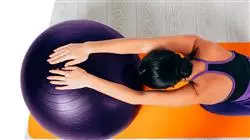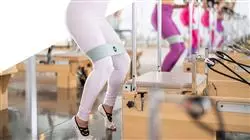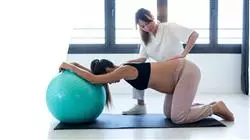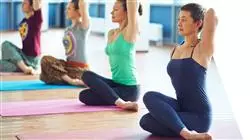University certificate
The world's largest faculty of sports science”
Introduction to the Program
You will have an effective update in the advances of the Pilates Method on Machines, thanks to this 100% online qualification"

The Machine Pilates Method has become an increasingly popular training technique, especially among athletes and high-performance sportsmen and women. This is due to its focus on core strengthening, improved flexibility, and body alignment.
For this reason, some training centers and fitness specialists have begun to incorporate Pilates equipment into their work practices to offer athletes the opportunity to experience the benefits of this technique. In addition, specific training programs are being developed for them, adapting Pilates machine exercises to complement their needs and sporting goals.
Consequently, TECH has developed this Postgraduate diploma that offers professionals a valuable update on the latest techniques of the Pilates Method on Machines. In this way, physical trainers will be able to keep informed about the progress in the use of various equipment to implement this discipline in their sessions. In addition, they will deepen their knowledge of the fundamentals of the method, which will allow them to deal with the most frequent injuries with greater precision and to select the appropriate exercises for each sport.
Following this approach, the degree is presented in a 100% online format that favors the combination of personal and work activities with those of this update, as it is not subject to fixed schedules. In addition, the program provides the graduate with a series of multimedia resources, such as real case studies and video summaries, supported by the Relearning system, which guarantees that the professional will remember the most complex concepts in less time and without much effort.
You will update your knowledge of the main equipment in Pilates Methods, such as the Barrel, the Chair, and the Flexible Ring"
This Postgraduate diploma in Pilates Method on Machines contains the most complete and up-to-date scientific program on the market. The most important features include:
- The development of practical cases presented by experts in Physiotherapy and Pilates
- The graphic, schematic, and practical contents with which they are created, provide scientific and practical information on the disciplines that are essential for professional practice
- Practical exercises where the self-assessment process can be carried out to improve learning
- Its special emphasis on innovative methodologies
- Theoretical lessons, questions to the expert, debate forums on controversial topics, and individual reflection assignments
- Content that is accessible from any fixed or portable device with an Internet connection
You will identify the importance of a suitable environment, considering equipment preferences and the availability of implements to facilitate the practice of Pilates"
The program’s teaching staff includes professionals from sector who contribute their work experience to this educational program, as well as renowned specialists from leading societies and prestigious universities.
Its multimedia content, developed with the latest educational technology, will provide the professional with situated and contextual learning, i.e., a simulated environment that will provide an immersive education programmed to learn in real situations.
The design of this program focuses on Problem-Based Learning, by means of which the professional must try to solve the different professional practice situations that are presented throughout the academic course. For this purpose, the student will be assisted by an innovative interactive video system created by renowned experts.
You will deepen in the most suitable exercises during the practice of Pilates with Machines and its application in sports injuries"

You will incorporate different types of breathing and the importance of each Pilates exercise into your physical training sessions"
Syllabus
This Postgraduate diploma has been designed with the purpose of providing the physical trainer with an update in relation to the Pilates Method on Machines In this way, the specialist will delve into the use of equipment such as the Reformer, the Chair, and the Barrel. In addition, you will expand your knowledge of various aspects of the method, including types of breathing, analysis, effects, and conclusions. Also, you will delve into the biomechanics of the spine and its applications in Pilates. This, with a variety of innovative materials such as in-focus videos and real case studies, will allow you to delve into the most complex concepts in the practice of this discipline.

With the Relearning method, you will reduce the long hours of study and focus your attention on the key concepts"
Module 1. The gym/Pilates studio
1.1. The Reformer
1.1.1. Introduction to the Reformer
1.1.2. Reformer Benefits
1.1.3. Main exercises on the Reformer
1.1.4. Main errors on the Reformer
1.2. The Cadillac or Trapeze table
1.2.1. Introduction to Cadillac
1.2.2. Cadillac Benefits
1.2.3. Main exercises on the Cadillac
1.2.4. Main errors on the Cadillac
1.3. The chair
1.3.1. Introduction to the chair
1.3.2. Chair benefits
1.3.3. Main exercises on the chair
1.3.4. Main Errors on the chair
1.4. The Barrel
1.4.1. Introduction to the Barrel
1.4.2. Barrel Benefits
1.4.3. Main exercises on the Barrel
1.4.4. Main errors on the Barrel
1.5. "Combo" models
1.5.1. Introduction to the Combo model
1.5.2. Combo model benefits
1.5.3. Main exercises on the Combo model
1.5.4. Main Errors on the Combo model
1.6. The flexible ring
1.6.1. Introduction to flexible ring
1.6.2. Flexible ring benefits
1.6.3. Main exercises on the flexible ring
1.6.4. Main Errors on the flexible ring
1.7. The Spine Corrector
1.7.1. Introduction to Spine corrector
1.7.2. Spine corrector benefits
1.7.3. Main exercises on the Spine corrector
1.7.4. Main Errors on the Spine corrector
1.8. Implements adapted to the method
1.8.1. Foam roller
1.8.2. Fit Ball
1.8.4. Elastic bands
1.8.5. Bosu
1.9. The Space
1.9.1. Equipment preferences
1.9.2. The Pilates space
1.9.3. Pilates instruments
1.9.4. Best practices in terms of space
1.10. The Environment
1.10.1. Environment concept
1.10.2. Characteristics of different environments
1.10.3. Environment choice
1.10.4. Conclusions
Module 2. Fundamentals of the Pilates Method
2.1. The different concepts of the method
2.1.1. The concepts according to Joseph Pilates
2.1.2. Evolution of Concepts
2.1.3. Subsequent generations
2.1.4. Conclusions
2.2. Breathing
2.2.1. The different types of breathing
2.2.2. Analysis of types of breathing
2.2.3. The Effects of breathing
2.2.4. Conclusions
2.3. The pelvis as the core of stability and movement
2.3.1. The Joseph Pilates Core
2.3.2. The Scientific Core
2.3.3. Anatomical basis
2.3.4. Core in recovery processes
2.4. The organization of the shoulder girdle
2.4.1. Anatomical Review
2.4.2. Shoulder Girdle Biomechanics
2.4.3. Pilates applications
2.4.4. Conclusions
2.5. The organization of lower limb movement
2.5.1. Anatomical Review
2.5.2. Biomechanics of the Lower Limb
2.5.3. Pilates applications
2.5.4. Conclusions
2.6. The articulation of the spine
2.6.1. Anatomical Review
2.6.2. Biomechanics of the Spine
2.6.3. Pilates applications
2.6.4. Conclusions
2.7. Body segment alignments
2.7.1. Posture
2.7.2. Posture in Pilates
2.7.3. Segmental alignments
2.7.4. Muscle and fascial chains
2.8. Functional integration
2.8.1. Concept of functional Integration
2.8.2. Implications on different activities
2.8.3. The task
2.8.4. The Context
2.9. Fundamentals of Therapeutic Pilates
2.9.1. History of Therapeutic Pilates
2.9.2. Concepts in Therapeutic Pilates
2.9.3. Criteria in Therapeutic Pilates
2.9.4. Examples of injuries or pathologies
2.10. Classical Pilates and therapeutic Pilates
2.10.1. Differences between the two methods
2.10.2. Justificación
2.10.3. Progresiones
2.10.4. Conclusiones
Module 3. Pilates in sports
3.1. Soccer
3.1.1. Most Common Injuries
3.1.2. Pilates as treatment and prevention
3.1.3. Benefits and objectives
3.1.4. Example in elite athletes
3.2. Racquet Sports
3.2.1. Most Common Injuries
3.2.2. Pilates as treatment and prevention
3.2.3. Benefits and objectives
3.2.4. Example in elite athletes
3.3. Basketball
3.3.1. Most Common Injuries
3.3.2. Pilates as treatment and prevention
3.3.3. Benefits and objectives
3.3.4. Example in elite athletes
3.4. Handball
3.4.1. Most Common Injuries
3.4. 2. Pilates as treatment and prevention
3.4.3. Benefits and objectives
3.4.4. Example in elite athletes
3.5. Golf
3.5.1. Most Common Injuries
3.5.2. Pilates as treatment and prevention
3.5.3. Benefits and objectives
3.5.4. Example in elite athletes
3.6. Swimming
3.6.1. Most Common Injuries
3.6.2. Pilates as treatment and prevention
3.6.3. Benefits and objectives
3.6.4. Example in elite athletes
3.7. Athletics
3.7.1. Most Common Injuries
3.7.2. Pilates as treatment and prevention
3.7.3. Benefits and objectives
3.7.4. Example in elite athletes
3.8. Dance and performing arts
3.8.1. Most Common Injuries
3.8.2. Pilates as treatment and prevention
3.8.3. Benefits and objectives
3.8.4. Example in elite athletes
3.9. Roller Hockey
3.9.1. Most Common Injuries
3.9.2. Pilates as treatment and prevention
3.9.3. Benefits and objectives
3.9.4. Example in elite athletes
3.10. Rugby
3.10.1. Most Common Injuries
3.10.2. Pilates as treatment and prevention
3.10.3. Benefits and objectives
3.10.4. Example in elite athletes

You will improve your workspace, incorporating the equipment indicated in the exercises of Pilates on Machines"
Postgraduate Diploma in Pilates Method on Machines
The Machine Pilates method represents a fascinating evolution of the traditional Pilates approach, taking the practice to a deeper and more challenging level. Using machines such as the Reformer, Cadillac and Wunda Chair, this variation of Pilates offers a unique experience that combines controlled resistance, precise alignment and mindfulness in a single movement. Are you ready to take your Pilates practice to the next level? This Postgraduate Diploma created by TECH Global University gives you the opportunity to explore the full dimension of this transformative exercise method using specialized machines. Through rigorous education and enriching hands-on experience, you will be prepared to guide others to greater strength, flexibility and wellness. Our team of highly trained instructors will guide you on your learning journey. Through interactive sessions, you'll gain an in-depth understanding of how the machine Pilates method can be applied in a variety of contexts, from gyms and Pilates studios to rehabilitation clinics.
Study a Postgraduate Diploma in Machine Pilates Method
This program will take you on an in-depth journey into the machine Pilates method. You will learn how these specially designed machines (Reformer and Cadillac), can intensify and diversify your Pilates practice. You will discover how to use controlled tensions and variable resistance to effectively strengthen and tone every muscle in the body. As you progress through the Postgraduate Certificate, you will acquire the skills to create customized Machine Pilates programs. You will learn to design exercise sequences that align with the goals and capabilities of your clients, whether they are looking for strengthening, rehabilitation or simply improving their overall wellness. Your ability to adapt and customize will make your approach truly unique. Completing this Postgraduate Certificate will prepare you for a career in an ever-growing field. You will be able to work as a Machine Pilates instructor in specialized studios, wellness centers and rehabilitation settings. Your ability to offer a versatile and challenging Pilates practice will make you a valuable resource for those seeking to improve their health and fitness.







